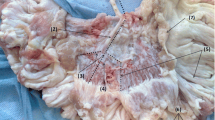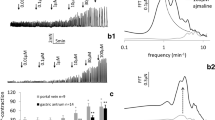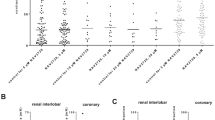Summary
1. Responses to adenosine, AMP and ATP were studied in isolated helical strips of renal and coronary arteries. The three substances caused relaxation of the strips, the degree of which was dependent on the concentration of the substance in the bath. Only adenosine produced a greater relaxation (in milligram per milligram helical strip) in strips of coronary arteries as compared to renal artery strips.
2. In equimolar concentrations, the relaxing effect of ATP on helical strips of coronary arteries was twice that of either adenosine or AMP.
3. Dipyridamol caused relaxation of renal and coronary artery strips. No significant difference in the degree of relaxation between the two different arteries was observed.
4. The relaxation of strips from coronary and renal arteries caused by adenosine and dipyridamol was virtually independent of α- and β-adrenergic blockade.
5. Adenosine and dipyridamol produced contractions of isolated longitudinal portal vein strips. The strongest effect was observed when the two drugs were administered simultaneously. Concomitant with the increase in tension the frequency of the spontaneous mechanical activity increased.
Zusammenfassung
1. Adenosin, AMP und ATP bewirkten sowohl an Streifen von Nierenarterien als auch an Streifen von Coronararterien konzentrationsabhängige Spannungsabnahmen. Adenosin bewirkte bei Coronargefäßstreifen eine stärkere Spannungsabnahme pro Milligramm Gefäßstreifen als an Streifen von Nierenarterien.
2. Das Verhältnis der Wirkung äquimolarer Dosen von Adenosin, AMP und ATP auf die Spannungsänderung von Coronarstreifen wurde geprüft. Adenosin und AMP verursachten etwa gleich große Spannungsabnahmen. ATP war jedoch etwa doppelt so wirksam.
3. Dipyridamol bewirkte an Streifen von Nieren- und Coronararterien Spannungsabnahmen. Zwischen der Spannungsabnahme (Milligramm/Milligramm Gefäßstreifen) an Streifen von Nieren- und Coronararterien bestand kein signifikanter Unterschied.
4. Die durch Adenosin und Dipyridamol bewirkte Spannungsabnahme an Streifen von Coronar- und Nierenarterien konnte durch adrenergische α- und β-Receptorenblocker nicht beeinflußt werden.
5. Adenosin und Dipyridamol verursachten an longitudinal geschnittenen Streifen der Vena portae Spannungszunahmen, welche am größten waren, wenn die beiden Pharmaka gleichzeitig verabreicht wurden. Bei Spannungszunahme nach Gabe von Adenosin und Dipyridamol trat eine Frequenzerhöhung der Spontanrhythmik auf.
Similar content being viewed by others
Literatur
Axelsson, J., B. Johansson, O. Jonsson, and B. Wahlström: The effects of adrenergic drugs on electrical and mechanical activity of the portal vein. Bibl. anat. (Basel) 8, 16 (1966).
Barr, L., D. F. Bohr, and V. Headings: Recovery of carotid artery strips from cold storage. Fed. Proc. 19, 258 (1960).
Bretschneider, H. J., in: 4. Freiburger Kolloquium „Kreislaufmessungen“, p. 104–125. München-Gräfelfing: Werk-Verlag Dr. Edm. Banaschewski 1963.
— Pharmakotherapie coronarer Durchblutungsstörungen mit kreislaufwirksamen Substanzen. Verh. dtsch. Ges. inn. Med. 69, 583 (1963).
Bunag, R. D., C. R. Douglas, S. Imai, and R. M. Berne: Influence of a pyrimidopyrimidine derivate on deamination of adenosine by blood. Circulat. Res. 15, 83 (1964).
Fleisch, A., u. R. Domenjoz: Die gefäßerweiternde Wirkung von Adenylsäure und Adenosintriphosphorsäure. Klin. Wschr. 19, 984 (1940).
Franklin, K. J.: The physiology and pharmacology of veins. Physiol. Rev. 8, 346 (1928).
Funaki, S.: Electrical and mechanical activity of isolated smooth muscle from the portal vein of the rat. Bibl. anat. (Basel) 8, 5 (1966).
Gerlach, E., u. B. Deuticke: Bildung und Bedeutung von Adenosin in dem durch Sauerstoffmangel geschädigten Herzmuskel unter dem Einfluß von 2,6-Bis(diäthanolamino)-4,8-dipiperidino-pyrimido(5,4-d)pyrimidin. Arzneimittel-Forsch. 13, 48 (1963).
— Vergleichende Untersuchungen über die Bildung von Adenosin im Myokard verschiedener Tierspecies bei Sauerstoffmangel. Klin. Wschr. 44, 1307 (1966).
Hashimoto, K., S. Kumakura, and I. Tanemura: Mode of action of adenine, uridine and cytidine nucleotides and 2,6-bis(Diäthanol-amino)-4,8-dipiperidino-pyrimidino(5,4-d)pyrimidine on the coronary, renal and femoral arteries. Arzneimittel-Forsch. 14, 1252 (1964).
Jacob, M. I., and R. M. Berne: Metabolism of purine derivatives by the isolated cat heart. Amer. J. Physiol. 198, 322 (1960).
Koss, F. W., G. Beisenherz u. R. Maerkisch: Die Eliminierung von Adenosin aus dem Blut unter dem Einfluß von 2,6-Bis(diäthanolamino)-4,8-dipiperidino-pyrimido(5,4-d)pyrimidin und Papaverin. Arzneimittel-Forsch. 12, 1130 (1962).
Kübler, W., u. H. J. Bretschneider: Kompetitive Hemmung der katalysierten Adenosindiffusion als Mechanismus der coronarerweiternden Wirkung eines Pyrimido-pyrimidin-Derivates. Pflügers Arch. ges. Physiol. 280, 141 (1964).
Nayler, W. G., J. M. Price, and T. E. Lowe: Inhibition of adenosine-induced coronary vasodilatation. Cardiovasc. Res. 1, 63 (1967).
Schröter, H. W.: persönliche Mitteilung.
Thurau, K.: Renal hemodynamics. Amer. J. Med. 36, 698 (1964).
Winbury, M. M., D. H. Parierski, M. L. Hemmer, and W. E. Hambourger: Coronary dilator action of the adenine-ATP series. J. Pharmacol. exp. Ther. 109, 255 (1953).
Wolf, M. M., and R. M. Berne: Coronary vasodilator properties of purine and pyrimidine derivates. Circulat. Res. 4, 343 (1956).
Zuberbuhler, R. C., and D. F. Bohr: Responses of coronary smooth muscle to catecholamines. Circulat. Res. 16, 431 (1965).
Author information
Authors and Affiliations
Additional information
Mit Unterstützung der Deutschen Forschungsgemeinschaft.
Rights and permissions
About this article
Cite this article
Walter, P., Bassenge, E. Wirkung von ATP, A-3,5-MP, Adenosin und Dipyridamol an Streifenpräparaten der A. coronaria, A. renalis und der V. portae. Pflügers Archiv 299, 52–65 (1968). https://doi.org/10.1007/BF00362541
Received:
Issue Date:
DOI: https://doi.org/10.1007/BF00362541




